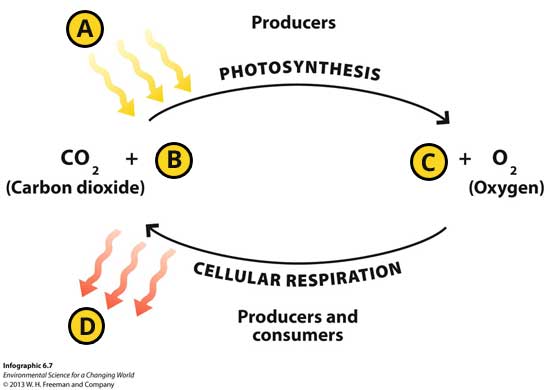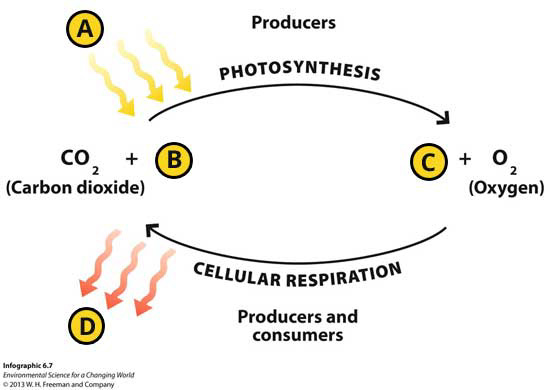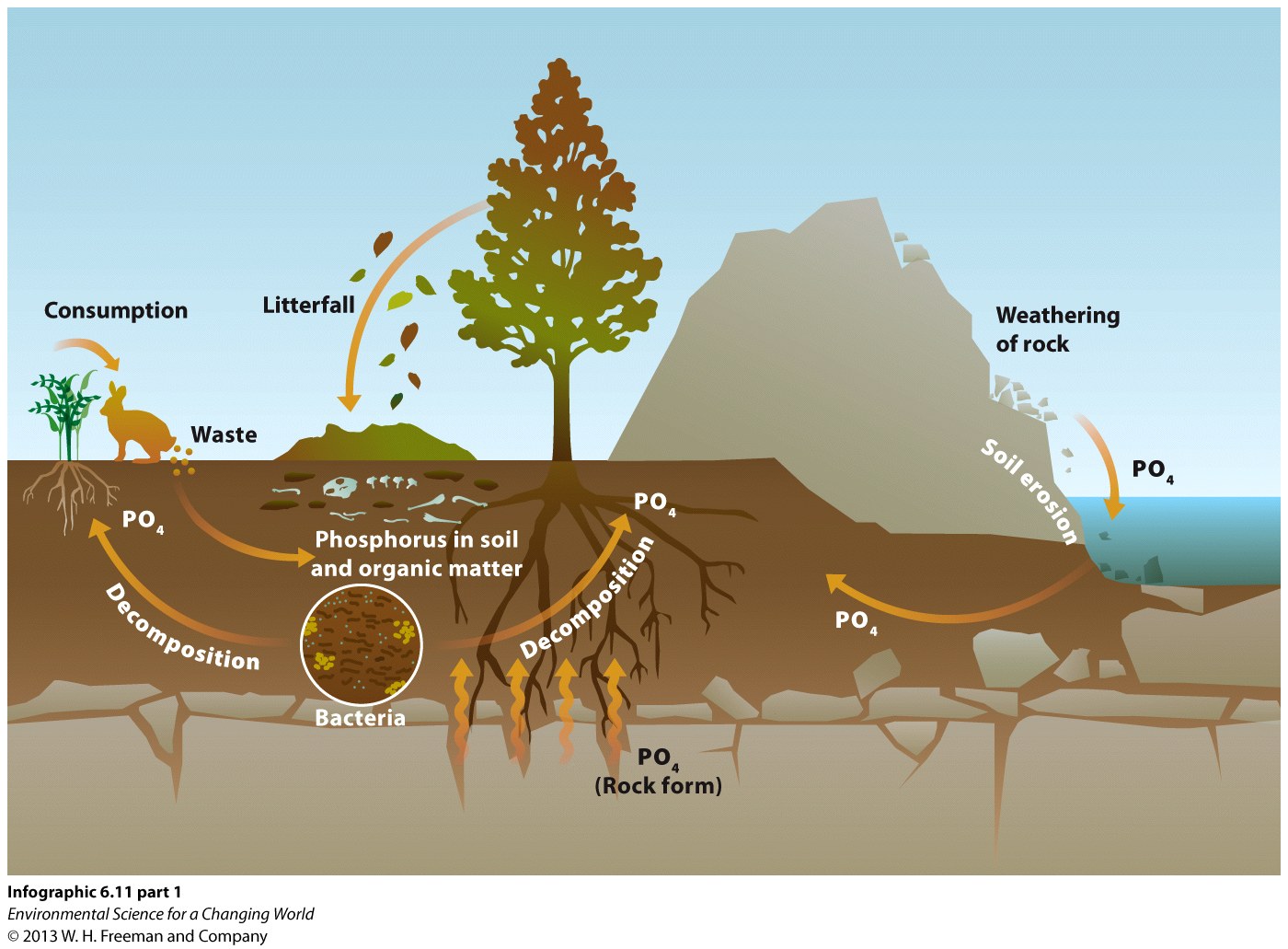Chapter 6. Chapter 6: Ecosystems and Nutrient Cycling
How do important nutrients like carbon, nitrogen, and phosphorus cycle...

Guiding Question 6.4
How do important nutrients like carbon, nitrogen, and phosphorus cycle through ecosystems?
Why You Should Care
As you have learned, the Earth is a closed system for matter; elements required for life travel through the biosphere in cycles. Understanding the carbon cycle is important because it relates directly to food production and global climate change. The nitrogen and phosphorous cycles are essential for plant growth, and when not functioning properly can lead to eutrophication—pollution caused by "fertilizing" bodies of water, which can cause fish kills and poisonous red tides.
Question Test Your Vocabulary
Choose the correct term for each of the following definitions:
| Term | Definition |
|---|---|
| rmWpVP86ek69WRC/zudbI3WGPBUneUwx2c5HiYElFUZP2OoufR3g2DP0yCH70GZRR/T0csceQQ3vPx+g4+GVGu12hTmYiSbjKVV7Lqi3nKBvo2pM4gRGmwWv3M43RtAYCJrjGj8DdbV5YuFU5L9AJwXSYb7vrDpmj5c+KIjTqQSdxYs8qZA4mNu+Y+5NZflECpwb3w== | The process in which all organisms break down sugar to release its energy, using oxygen and giving off CO2 as a waste product. |
| sl+cOTkfbTSbv3z7Ka/fnptHVQm/WikAnB2G+BhKHBq7Fp+eEch7j34Lg83ovt3fWc53YvbhyZngq3bTXt4O63wak3ryx7c9qBmEEKqNxvsxV4LvaIuRdE9tgcJVmVMtv0fq6KU7S4vnm9s0WONqH56nBheddPy/46Ez4gCqPjXyZWgngYe0gbHEvBOr7old0OhaFQ== | Movement of carbon through biotic and abiotic parts of an ecosystem. Carbon cycles via photosynthesis and cellular respiration as well as in and out of other reservoirs such as the oceans and soil. It is also released by human actions such as fossil fuel burning. |
| MnznlQ8ef6GN1Mpq8pTrvfa33wkHc87sg7VzyYS9uE/NZKeg3mtIseP2WaW2tDSYoSb65durdDk1rWVbegc4u9Rt9ODwqFsOmUm8sU7EAje3Lsq1YOmAO8eeBjqHQPhq6pb1MUM2k/AvxExemfAzt6aOMPEgPHc0FN5GZTVEVxcgwOUn1HsLFCWM14/Y4XFvhA73uQ== | An organism that converts solar energy to chemical energy via photosynthesis. |
| ENu/9HNr4IWBG8QGwPehxrE8TN8WlHvvSSvIK2T5+MuqBcIJhvR7QURKdmMp3X+z9c6Y0aus9YA1nRZSKqEQNgVNhtyEHjJMLSq0iDKRJFs+8yXqIouZgFz4ro6dUUDAgzkZtVCemPHo0thLQ19kPWRGjDxbiaUrCWyjlu5LhIYPvGwDMOpgE/un2LIfLhsjJylNjw== | Series of natural processes by which the nutrient phosphorus moves from rock to soil or water, to living organisms, and back to the soil. |
| rCBnUqI54vVsyvobA/7J2iMusmSoKfDF7U3FMPokElCvlEwCxL5eNg4tLuvfy64f1sEvA5ZVfYhtaU0v+IBnlQCHN2gWvvnxb+mSqFtJJ3X5fUHiYjbVZKFI2DROwMTNLEBsDl2UwPPrd5pXshz22O5u9SXYArKiQ2FtVoDPg7NyNOAaugWzUbvy2z+adkU0EFxIaQ== | The living (organic) components of an ecosystem, such as the plants and animals and their waste (dead leaves, feces). |
| uHDXECrDWFfECriHXnhiuLBtMHkSyIbWLzwnKX4lBcFj85KX5htqGRWwElI/PvJx3nmGgOJKYM28cJ6dUjRO1qtbI0O8r04q0czE8FrxZPHD0DcMlq4duU/tBIjIvmat2lz3qKLil5HiWih6cBp4t2tfKxBhGRvdJuyT/Kq2hcNcZNEJRUYsQ8Kyn5dwccBA2ymOTA== | Continuous series of natural processes by which nitrogen passes from the air to the soil, to organisms, and then returns back to the air or soil through decay or denitrification. |
| H/H7SEXATpXWubkzLMnFSEJXD0NvHRszDB1QZueU5kqFunNOkQV5B9RSx4NTG0XtiZfsOdYMHrykBA2+hDLdQxtwM1Q+M7mynsY9B6eqMuf/ooI9roRaoA4QJN7/whFZ4QfjAzTuCjmmukeKcgFIiB2M5NabXHdn9NLpeqj9xUooIihkz6+2k5VWeBDLgG+SqhgUFA== | Abiotic or biotic component of the environment that serves as a storage place for cycling nutrients. |
| Vne8Q9UAlnHjRZoIq67dKFMVK/zf9ItN9okz0S0neRLguKIwKSE5ixS8SgkPtXL3/Pnru57taEwP2eZhGcZdoTJO85hScbjlVyNXpO3FzEKIDs7XHM0J3JZfan9P83cc3uNt21LtbaBziBcXMaxCPDzUFiv7u27PcSaynBOJW06FXpbKD2xbzqYSe3caqa88zJV0tw== | An organism that obtains energy and nutrients by feeding on another organism. |
| NeAttSypM9jwwxPJuN5Ej5MOwhCC/nN93aGpIqZGYGIH4UQArxRsBX802TVALPTAfII3S3wQ+MXy52mePL9KFouCmHZUlz4llwFRYpY3LUIr4MS/XX8Klgd/d8AdSjcVTSJaPOgJr4AaU+nJHXbWh6rhkmXJDmiQX+7wFpSfPwRLARu9j9YVB8sq/IB9bylzrBUsIg== | The nonliving components of an ecosystem, such as rainfall and mineral composition of the soil. |
| GlkjPdO9mGQduObtUEve7uydJI6SvVOF4Ir5goRuAikQbXMDpb+VnRZGCdbfTi2JGqHidzar/nBovnFpqBkV/th/KVcBA8bfN3TsPZqpJREHnBo9cf3LW/rx/nplBjZ24TKFQaoWqa+AQx8j7WDlMRITEGcLqSX8EfLOTeQqb+tSjTzZvryRXYROLdTYfcd3I+sNaw== | Conversion of atmospheric nitrogen into a biologically usable form, carried out by bacteria found in soil or via lightning. |

Question 6.1
2ai9HkfzBiDDmjMW9imB4szgE12AJzJNyE00bmM0suk9u3uodV68iWA90C447jQWRLgu4WcbxVU0XgbN2beiElwx6Oda20yueUQ8GRSOPF8JbLMGPToYkcfGIvP+uE5hK4hlmptbLYtDsEt2NGeNTJ4LT8lm3TrvVW8hRCbrQs1T25mZkB8SsBuutr4LZN1+hKvAu/7kHGicH65A0gv5ja8anVTf5yUtLimLFuufFctFLjFKXxPnGofo7nHHnjXZCnsB8rfdF8L6S1ftBxkLrrAYjjFoqvV+eFDI115x7ghJz8ah+I4rK2qKjimJ+T0vR1okG4mlXjvJNiJM3pxFQvXTenqchmQlp+hJ5OnPRug=Question 6.2
hctJj6fToYa4sPfmbOQat4FaI6TuQHVOwRw3NRDENRCxadwz1cKDIKOKX0AkKCgHnhNwmibm7T5tQMUC0TItFzVFtH4jTKlwJwByTf75M2BOz7Erw0yWcn8xHZWxYQSn1xwFYlcEYRVk1ALSYSgvCLUvRGIc88eWuA50yWhm8IrhdhPTc+M4J/Tj8QA10o95VDD8NK1vomCndHcNMLRFAYfeakqDyeZf5a+ZmAztKLeNXLOxkBXDQZZfGXvweOwHw7JI5g0vXh5bUWGLPdxgcNgoulGtM9zTFGebl9P5D12HIyj7zyhJYyfv2s/mtAClceEIJk6Aff2Su5utQuestion 6.3
4bK8iXVvTliyCrxxgm8MXRKl3bQuyVv3Y7go2DiKQ55ZR2/5kstqWugubsQUTVp2AX2fgRQv3ZJTRaFcBoUU7WiB6PkAWzRq6i09LOOmDR3C2ZqUPx9/Z9iRYxohq0ORlmSg51PoFO/+ig9ovmjACzkQnqM5fTA/q37XPVgjtnH7eR0fcxVWBag6wE7dNGSZQuFglYpa1HiTf6KQPJsv/9KlFb26K537dt2P2u3vYfsgL5BmYYCoUcZNXh3ac6k5CrUpDW67Vhene+AFyIGMRiTdtO0RXkbWQNhm8z9W/WgZAXruaR9JyWY3Ua/kWNOgMA2hjBQXAHw=Question 6.4
RmadtM9uttVEmnE5SRzyd5Sz6sH1En9qVeaj6y8Ic9uSHML2uzOCNMA3+hr005/OeskJhk4U8VE48TM2s90auoeq8Ulp2pvI5ckki7uRBnIcYS3t3PALnb4OYrfLeYuKQXDlp0LgeVE=
Question 6.5
qd7FXDhnv4Ki3e2Dcb7BZhGL4L3TeAvpAtYeQ3GVpfU7URdxMnLYYGzCM/4cteAfx/Na0KSdcS0m88WN+2cCIvKyGjWwVJeJ6FQFnpKrKqC8FzFwNWb8BfyRKvzB1b0d
Question 6.6
1IpQHZdwuFoAqXa2/h+8/aZYNrTtuxzI9ivXRU8Wboh2jDFo5KeM33jQQfSooNZrcX6/KG/qiuo/n9RQdYVgiZ/W2tQmkCWuoSRSwM6Ohf9UH4oLKdc2JZ5k5Y1NziuL
Question 6.7
ZbGoN9EFgbVvnxvk5zKzsMQ7hyLNp3+IAhiiZ6CHkdQE+MryRrVNVXI10LSGuK+4wrM+/DKsqxCTexvFS58nMtc1FhIDK0pbd4DWVgeoP9s1lYch+VjGAOsHT5u/oMm8+MfCLyq4pbLdHXm+41aEyf3Rkh8=
Question 6.8
RruESmpbQn0ZbKrroWG77rhUKEzCaRIeMra9pfvDug+e41Eyh/Wr5mOgZTABg6/gHWkcSiDHwnuBnz3shhxx640qOQ/KpjYtHUh3d+a7JlKiJILIQuestion 6.9
z356s4yItVqvf4P4CybwOwB0L0F2BS3+Bpyz9CCpksNmAMKjUeuMuyDzQwtXtDGtMbGxootsllJRbhPOCOwMVk0ozTgQ6R/4wf0yPsMzNw3pnQBf+qVj/P/jR5ShQZatlQm3Uo6NNIeTDPigbgbFCMWBkoCkJnxgrJqDC1EgUf4P9hVhsB/jSaNvzEV3ORTYXNnjkEyxB7VO3Uo2MrG6a8IkmJpxSap19GrSAWgCqm+45ANRQuestion 6.10
Choose whether "releasing" or "taking up" carbon dioxide is correct for each of the following:
- Photosynthesis in plants YJInoU3XqQwqFs7hiSFdUvqpfoAxsU1oUKS+Pw==
- Cellular respiration in plants S+mcF+WGc123WlK1X6acxvR3bGdoBqmd
- Decomposition of animal bodies TbgufEkYWX9akJu6Tgm2ckw8+YyoAuRD3L93aw==
- Utilizing prey as a source of energy TbgufEkYWX9akJu6Tgm2ckw8+YyoAuRD3L93aw==
- Burning fossil fuels TbgufEkYWX9akJu6Tgm2ckw8+YyoAuRD3L93aw==
Question 6.11
MwmaD2wPsnjc1e5yG1MI5K6icgRoQHKkGnwGtmN3sJmBgJHF3gcl3m3Ezt3Uo2g8hBKaTVW9uq6/qbJvOkUFDitOUY5d+e1X99l6nfsu2b1wUyqp4JMA0TRJSAhVnkB7EbSZQHlgYUmOZ9geMsoZhGB1a3glGSe810x5rdojT+1miIG+LeQoaucgqEdTlHrHJNWxSnEvSpsVqmEimJcX89vOswAm5jBKCEGd1apWTnjmgxAdy84GPLSkpmuDRm0MZoUneuEX0MQtZCA5Jry5T4Il+874yp7WfYoue/6GOzIJjn8tGfScx12tLHkHFrBJOlO/FwTrgcjaaFF2931xLYAoYrluTRapxtFvNqnn5pA=Question 6.12
E9rntML0Gm28JjYfv+IuEqA/6BwECY2eq/k9oFEzdGMEdFvrYEwmwftP7fuvA3hu5xWObPmeoTGaILAqJOnfWudAFtsa6vuhnmYZO/Ykje6rBBb2tp37LE5GD1cf1F63Nx7uu1bSUCGW2PXU4sj6CnS78qPvmdwpI6bOfua+0ugw4UPNDByf82P/Boik+mm9KRJ0DLRKC54A6nS13ow4ETnb1Z8/H/KOpBJGri0ak8Gu7T3HCZbWLshBhyznlhGnK+e+2CfDkrniGHhS2gYeYE1JM+Kk1VorB1+ZJKcJmveqbGspmZlnkeTkAn6lJ+MbW+qAh8ryobOxI+u0PDjocggQYms6hge+Since plants also take up carbon dioxide for photosynthesis, they usually contribute little, if any, net CO2 back to the atmosphere.

Question 6.13
Remember, it's best to try to do review questions without the help of your text the first time.
Which of the following are forms of nitrogen that plants can use as a nutrient? (Check all that apply.)
Molecular nitrogen (N2) s87TBEH0BM9yDZCI
Ammonia (NH3) 9PufMCe/gaVcshPB
Amonium (NH4+) 9PufMCe/gaVcshPB
Nitrate (NH3-) 9PufMCe/gaVcshPB
Question 6.14
Which of the following are sources of nitrogen that are usable by plants? (Check all that apply.)
Lightning 9PufMCe/gaVcshPB
Decomposition 9PufMCe/gaVcshPB
Nitrogen fixation 9PufMCe/gaVcshPB
Denitrification s87TBEH0BM9yDZCI
Question 6.15
Which of the following processes convert organic nitrogen from animal and plant matter back to ammonium (NH4+), a form that is usable by plants? (Check all that apply.)
Denitrification s87TBEH0BM9yDZCI
Nitrogen fixation s87TBEH0BM9yDZCI
Decomposition 9PufMCe/gaVcshPB
Nitrification s87TBEH0BM9yDZCI
Question 6.16
e6TgqlfgkrKEOyusFaddb83yfPq0EHDbrsk2IF7drc1z3vJc/3lJYrJRMTl85maJar2DeG6hXxiA2HoL7oAONBWiJdJkbTr94oiZVEVX5UH6M+eX9oEs+cziSuDYb+6zuBCJBxqIkeWj7RgOi+BLWSaukRru89W6Z3ka1qt2kZOkIRAMe2aeGac1ADydy8yuCu+CWMyzsC1MFzn609nZjC4ZV9fs4mK4WVPM3Xy2LyPU452JgkFOBpICllSyd9XpQOg7BbSl86MtbGD95DDeKqKlQIjO0c5RWWR3o0+Ltp2biHuODpC783WjXjKQwxG4kit8fQ==
Question 6.17
0r6CbSJVKzOK3EN0IXPrm78SW2rKaGZYP/YjYwV2odRCGcVwQUbc7rmWrJgYH2iZkSSbB8Q3gYfB/4IewMB47CXQlDzbrVwfTTxjX+ipJHUN6NLN1TRe/AZ6OIDqMR0YP3epxBooNCj6pgOu8lU1Mm016aOQsTCRiFHdKKKB0xU5GGQbxEeanpE8sT6hGU3B6eDDw5bJxuUcRyUgabNpeSAbRBDqzEL0Ava9tA==Question 6.18
69lLxD0kCC0dd6uv+SZCZ3G1tAw8ipyICe3RTXVK+8OtyN4YuewVVkFUXYzSPmNdN0OzQRJzpapXT+pGwKekRzOED44E8bGXAbAuEcbbVMVsl/wxmttw+Rs8IpdMY8SJ6vKt12bfDrzr6P3L1ssyc/VyKPcSojHd3d1aeJG5/KgPmbvcU2mwt5l2UUEtuhddVHOEqzEXFC2+Sm2cNDUTLJ0tsFrjQhvIRhPYcZi7wGc=Question 6.19
Which of the following are ways in which phosphorous enters ecosystems in a form that is usable by plants? (Check all that apply.)
Phosphorylation s87TBEH0BM9yDZCI
Decomposition 9PufMCe/gaVcshPB
Weathering of rocks 9PufMCe/gaVcshPB
Consumption s87TBEH0BM9yDZCI
Question 6.20
qlGEvSOU4Rbbv0JqY5uW4fZ6OjtWglVgKxlfW7oYxuoJ7jc5zbe/m3C1rcyW7s30PfScfPx5ivkEYqXsUfp+JRz+zz87VGyAHwLDZis9hUD3EpxaMQJo9Q==• The main source of nitrogen is the atmosphere; the main source of phosphorous is phosphate-containing rock.
• Abiotic nitrogen enters the ecosystem through nitrogen fixation; abiotic phosphate enters the ecosystem dissolved in water from weathered rock.
• Soil microbes play a large role in both cycles.